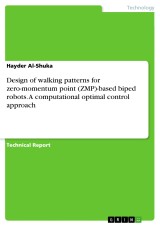Details

Design of walking patterns for zero-momentum point (ZMP)-based biped robots. A computational optimal control approach
1. Auflage
|
18,99 € |
|
| Verlag: | Grin Verlag |
| Format: | |
| Veröffentl.: | 13.08.2018 |
| ISBN/EAN: | 9783668772311 |
| Sprache: | englisch |
| Anzahl Seiten: | 52 |
Dieses eBook erhalten Sie ohne Kopierschutz.
Beschreibungen
Technical Report from the year 2018 in the subject Engineering - Robotics, , language: English, abstract: Biped robots have gained much attention for decades. A variety of researches has been conducted to make them able to assist or even substitute for humans in performing special tasks. In addition, studying biped robots is important in order to understand the human locomotion and to develop and improve control strategies for prosthetic and orthotic limbs. Some challenges encountered in the design of biped robots are: (1) biped robots have unstable structures due to the passive joint located at the unilateral foot-ground contact. (2) They have different configuration when switching from walking phase to another. During the single support phase, the robot is under-actuated, while turning into an over-actuated system during the double-support phase. (3) Biped robots have many degrees of freedom, and (4) interact with different unknown environments. Therefore, this work is focused on offline computational optimal control strategies for zero-moment point-based biped robots. Computational optimal control has been performed to investigate the effects of some imposed constraints on biped locomotion, such as enforcing swing foot to move level to the ground, hip motion with constant height etc. finite difference approach has been used to transcribe infinite dimensional optimal control problem into finite dimensional suboptimal control problem. Then parameter optimization has been used to get suboptimal trajectory of the biped with the imposing different constraints. In general, any artificially imposed constraint to biped locomotion can lead to increase in value of input control torques. On the other hand, suboptimal trajectory of biped robot during complete gait cycle had been accomplished with different cases such that continuous dynamic response occurs. Enforcing the biped locomotion to move with linear transition of zero-moment point during the DSP can lead to more energy consumption.

















